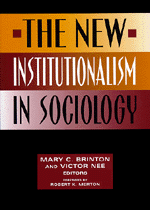

![]()
![]()

There are fourteen chapters plus an introduction, written by scholars in sociology, economics, anthropology, political science, law, education, and business. Each chapter is worthy of mention. (My summaries, of course, vastly oversimplify each contribution.) Four chapters have appeared elsewhere. Robert Ellickson's "Of Coase and Cattle" looks at disputes among ranchers in California. Though there are laws to protect property rights, the ranchers rely on informal resolutions rather than on the courts -- a strategy which is understandable in light of the transactions costs involved in negotiating the disputes. Douglass North's "Economic Performance through Time" -- the acceptance speech for his Nobel prize! -- shows how current economic theories of the market do not work well for developing countries which, by definition, lack established markets. Drawing on cognitive science, he sketches a preliminary theory of development. With such good company, the remaining chapters have a lot to live up to, and for the most part, they succeed.
Also previously published is Alejandro Portes and Julia Sensenbrenner's theoretical discussion of social capital and its application to immigrant communities and Avner Greif's examination of two groups of medieval traders. Portes and Sensenbrenner show that some forms of social capital can stunt desirable economic behaviors such as entreprenurism in the immigrant groups that rely on them. Similarly, Grief finds that belief systems can encourage or discourage the development of economic institutions. He compares traders who held different social beliefs, the Maghribi with collectivist norms and the Genoese with individualistic ones; the latter developed legal and organizational forms to enforce agreements, whereas the former relied on in-group members to generate trust and compliance.
Several of the chapters, including those by Ellickson and Grief, rely on rich empirical data. Looking at agricultural development in Medieval England, Rosemary Hopcroft shows that variations in the institutional structure of farming led to innovation in some regions but not others, highlighting the fact that specific local institutions, alongside institutions created by the state at national levels, can drive economic change. Paul Ingram examines the US hospitality industry to argue, consistent with population ecology, that new types of organizations are the source of new institutions in organizational fields. Iván Szelényi and Eric Kostello look at countries in socialist and postcommunist Eastern Europe to refine and extend Polanyi's classic institutionalism. And Mary Brinton and Takehiko Kariya show that embeddedness patterns vary by cultural setting. They examine organizational recruiting patterns in Japan to show that when laws change to prohibit large corporations from recruiting only at prestigious schools (what they call "institutional embeddedness"), social embeddedness -- ties between employed alumni and their schools' students -- becomes more important, but only insofar as it reproduces the earlier direct ties between schools and employers.
Other chapters are more theoretically focused, some purely theoretical and others illustrated with empirical data. In the first chapter, Victor Nee traces the roots of the new institutionalism in sociology, placing it specifically within the choice-theoretic tradition. In the second, Nee and coauthor Paul Ingram build a theory of social norms which draws on social exchange theory to explain the relationship between institutions and social networks. Jack Knight and Jean Ensminger also address social norms. They draw upon understandings of bargaining in situations with resource asymmetries to explain the stability and change in norms of bridewealth and female circumcision among the Orma of Africa. Gary Hamilton and Robert Feenstra describe the variations of economic organization, arguing that these are produced by the types of market connections within and across economies. Drawing on Walrasian economics (which is about the economy of interconnected markets, and is clearly explained for readers who do not know this approach), they argue that economists and sociologists should collaborate in analyses at the marco level, rather than looking at individual decisions and how they aggregate to form economies. Bruce Western looks at labor markets in a comparative perspective (eighteen advanced capitalist countries), arguing that the variation in industrial relations in contemporary capitalist societies, especially the degree of centralization and comprehensives in labor negotiations, determines labor market outcomes like unemployment level and income inequality. In a depressingly convincing chapter, Robert Frank looks at winner-take-all employment markets, where small differences in performance lead to large differences in income, and demonstrates that even minimal employee discrimination at the first stage of recruitment eventually leads to a large wage gap for women or minorities.
Nee and Brinton write: "New institutionalist sociology revisits the idea of context-bound rationality developed in the classical period of sociology and focuses on the social structural contest within which individual interests and group norms develop as well as on the reciprocal role of norms and interests in effecting institutional change," (p. xv). While this view covers very well the institutions-as-constraints model adopted by the authors, it neglects, as does the collection as a whole, the institutions-as-constitutive model; that is, while institutions constrain action, they also make it possible by shaping the rules of the game (on the macro level) and the cognitive schema (on the micro) needed for social interaction. In constituting action, institutions often give rise to intendely-rational behavior on the part of individuals, but they can also give rise to nonrational (unreflective and not profit seeking) action based on habit, roles, and tradition. I would have liked to see the authors address these issues, as well. Collections can be, and this one decidedly is, good at bringing together thoughtful contributions from a variety of perspectives. This book is very specific in its theoretical focus and consequently, will probably not find a broad audience. It is nevertheless an extremely important book for scholars in economic sociology and institutional economics and I expect it will become required reading for graduate students and academics in this area. It is dense with interesting ideas and points for debate and I heartily recommend it.
Vicki D. Alexander
University of Surrey